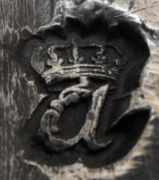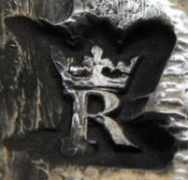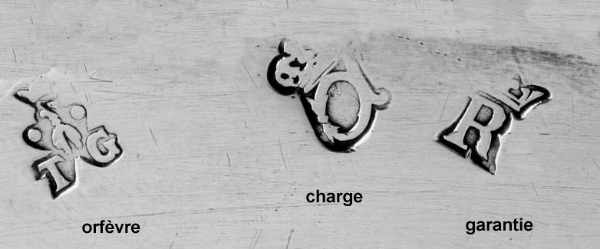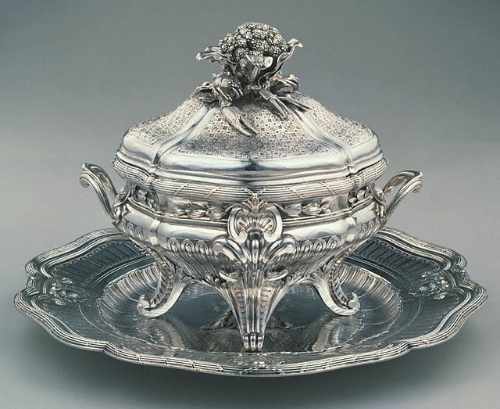(click on photos to enlarge image)
ANOTHER IMITATION OF LOUIS XV
SILVER HALLMARKS (III)
Paris 1733, Master Thomas GERMAIN,
appointed silversmith to the King
This new article presents a series of
apocryphal marks punched on a flat silver dish produced in Paris
in the late nineteenth or early twentieth century.
The dish with its lobed edges and double rim contour offers an
excellent representation of the taste of the eighteenth century
French silver workmanship.
Three counterfeited marks are present on the reverse of
the dish.
The marks are copies of legal punches
used during the reign of King Louis XV (1723-1774), namely:
- a "Charge" mark (meaning that the piece had been declared to
the tax authorities), a "crowned A" employed in Paris from 1732
to 1738,
- a Warranty Mark, a "crowned R", date-letter used in Paris in
1733-1734,
- the punch of the famous silversmith Thomas GERMAIN, provider
of the King of France and of several other European courts
(Master in 1720, died in 1748).
They are not authentic ancient marks, and the dish, made
according to the eighteenth century French style, is much more
recent. I would also note that the manufacturer of this object
renounced to tackle the problem of the reproduction of the
fourth punch expected to complete the legal series of eighteenth
century Paris hallmarks. This mark ("discharge") would be rather
difficult to imitate owing to its small size and the variety of
details in its design (a "passant horse").
Genuine Marks
 |
 |
"Charge", Paris,
year 1732-1738
Large objects
|
Warranty, Paris, date-letter "R"
year 1733-1734
|
The differences between the authentic
and the apocryphal punches are evident:
- on the fake punches almost no space outlines the letters
contour,
- much sharper contours on the design of the false marks,
- a rough error in the reproduction of the node of the lowercase
"A" of the "Charge" mark. The forger choose the wrong direction
on the "ribbons" facing outwards, instead of inwards,
- the false warranty mark (crowned R) shows a summary design and
sloppy details at the crown level.
The use of fake hallmarks in silverware was a widespread
practice in the 19th century Europe. The phenomenon interested,
among other, towns as London, Paris and Hanau (Germany) and
found its origin in the need to satisfy the market request of
pieces in "old style" bearing, possibly, the marks of
prestigious makers.
The result is that often such behaviour, possibly not fraudulent
at that time, is nowadays seriously deceptive not only for
collectors but also for sellers in good faith.
In our case the prestigious character of the dish results from
the presence of the mark of one of the most famous French
silversmiths active during the Ancien Régime (French Royalty),
Thomas GERMAIN. His mark was his initials TG surmounted by the
mythological "golden fleece", and a crowned lily (fleur-de-lys).
This punch, like the others, is false.
I give below a brief biography of this prominent master:
Thomas GERMAIN (1673-1748)
GERMAIN Thomas was born August 15, 1673 in Paris. He
obtained silversmith mastership in 1720. Appointed royal
silversmith to King Louis XV in 1723, he assumed the same duties
on behalf of the royal families of Portugal, Brazil, Spain, the
Kingdom of Two Sicilies, Denmark and the Sultan MAHMUT. On April
20, 1720, he married Anne Denise GAUCHELET, daughter of a
goldsmith merchant. He provided the many golden table services
of Louis XV and in 1726 the toilet of Mary LECZINSKA, Queen of
France. Thomas GERMAIN died August 14, 1748 in Paris, in the
Palais du Louvre, where he had a permanent official housing. His
wife Anne died on November 12th, 1758. King Louis XV ordered a
requiem mass in honour of his beloved silversmith.
Thomas GERMAIN created many models in "rocaille" style largely
reproduced after his death by his son, François Thomas GERMAIN,
born in 1726. Six months after the death of his father (1748),
François Thomas GERMAIN received by the king his silver
mastership.
Unfortunately, most of the silver and golden artefacts produced
by Thomas GERMAIN for Louis XV did not survive and have been
destroyed long time ago. This king, still called the "bien-aimé"
(well-beloved) by the French, suffered so many financial crisis
during his reign that he was forced to melt his own silverware.

www.silvercollection.it |
This is a page of A Small Collection of
Antique Silver and Objects of vertu, a 1500 pages richly illustrated website offering all you need to know about
antique silver, sterling silver, silverplate, Sheffield plate, electroplate silver,
silverware, flatware, tea services and tea complements, marks and hallmarks, articles,
books, auction catalogs, famous silversmiths (Tiffany, Gorham, Jensen, Elkington),
history, oddities ...
HOME - SITE MAP - SILVER DICTIONARY - COOKIES CONSENT AND PRIVACY
OTHER ARTICLES ABOUT: ANTIQUE SILVER
SILVER PLATE
ENGLISH SILVER
FRENCH SILVER
|
|
|






